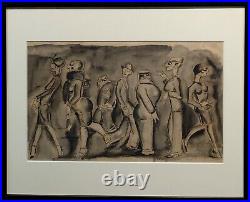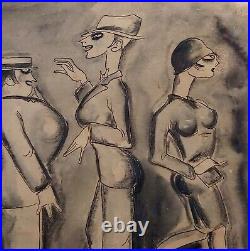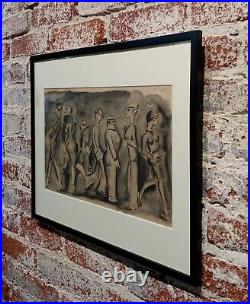John Held Jr. Caricature of People in the Street Painting c1925











Primarily searching for the "Unique & Rare" by dealing with some of the finest acquisitions and consignments of Prominent California Estates, Large Collections and Celebrity homes from Santa Barbara, Beverly Hills, Bell Air, Hollywood Hills, Los Feliz, Malibu, Pasadena, San Marino, Newport Beach, La Jolla and most of the best locations of the fabulous West Coast. Caricature of People in the Street - Painting c1925. Expressionist - Ink & wash on Paper - Signed. Frame size 17 x 21.
Was active/lived in Connecticut, Florida, New Jersey. He is known for Jazz-Age genre, flapper figures-illustration. A cartoonist, illustrator and comic-strip artist much associated with the'Roaring Twenties Jazz Age', John Held Jr. Had a perspective and sense of humor that both reflected and shaped a generation. His stereotypical flapper women were depicted as simple minded, flat chested and ever accompanied by a raccoon-coated beaux.
John Held Jr was born in 1889 in Salt Lake City, Utah. He came by his talent and interest in illustration through his father, who was a copperplate engraver who had illustrated an edition of The Book of Mormon.Was fifteen, he made his first sale, which was to the original Life magazine. The next year he took a job as the sports cartoonist for the Salt Lake City Tribune.
He drew streetcar posters, advertising art for Wanamaker's and for seed catalogues, and did an endless stream of cartoons and ads for magazines. In 1915, his work was appearing in Vanity Fair, but he was signing the work with his wife Myrtle's name. Naval Intelligence to accompany a pair of archaeologists on an expedition to Central America.
Purportedly sent to study Mayan art forms, Held's real job was to sketch the coastline and scout for sites for military operations. He spent most of the time developing his cartooning skills and honing a sophisticated edge on his humor. Some of that humor was seen in a 1921 issue of Century Magazine, and a 1927 issue of a new magazine called The New Yorker. His first recognized'John Held Jr. Flapper' appeared in 1920 in Judge magazine and was soon a staple in College Humor, Life, Vanity Fair, and Collier's. His flapper's high hemline, cloche hat, and the ardor of her Joe College suitors established themselves as the official portrait of the decade. Seldom have two generations experienced such a gap. Mothers who grew up with petticoats and hoop skirts must have looked at their flapper daughters and wondered how they could have gone'so' wrong. Held thought they were'so' right.In popular magazines like Vanity Fair, Harper's Bazaar, and Redbook, his images of Betty Coed and Joe College were placed weekly before an adoring public of parents who longed to see some humor in the situation, and the teenage and college crowd who looked to them as role and style models. The skirts were never quite that short, nor were the'sheiks' quite so pencil necked, but everyone wanted to believe that they were. Held's images reassured their delusions.
Held could do no wrong. People would send him blank checks begging for an original drawing. In the latter half of the decade, he appeared regularly in a half-dozen magazines, designed sets and costumes for Broadway plays, had two newspaper strips (Margie and Rah Rah Rosalie) and ran for Congress. In 1930, he wrote Grim Youth and had his famous woodcuts for The Saga of Frankie and Johnnie published in a limited edition. They appeared a generation later in the first issue of a new magazine called Playboy. He painted throughout his life and his book, The Most of John Held Jr.Contains many of his urban and rural watercolors. The book also gives insight into the artist's sense of humor, and can be sensed from the following excerpt:When we entered World War I in April 1917, (Ernest) Haskell was commissioned to help develop the new science of camouflage. I remember the astonishment of John, Hal (Burrows) and myself one day that summer when Haskell, on leave, told us the remarkable achievements of the Camouflage Corps. We can paint battleships in such a way that at sea they seem invisible a mile away, or even less. We're also devising camouflage of artillery concealment and even uniforms.
Come over to my flat and I'll show you a raincoat a Heinie can't recognize two hundred yards away. Haskell left his living room a moment and reappeared wearing a doughboy helmet and raincoat, both painted with a dadaistic confusion of reds, greens, yellows, blues, and browns.
He stood about 6'2 and now gave the appearance of a nightmarish Pierrot. While the rest of us stared at his weird appearance, John stretched out his hands like a man groping in the dark, My God!
" John cried, "Where's Ernie? At the peak of his popularity, John Held Jr.
At one point he was earning over a million dollars a year and kept a home in Miami, a penthouse in the East 60s in New York, and a 163-acre estate in Westport, Connecticut, with its own zoo and golf course. The early 1930s proved far more difficult. With the onset of the Depression, the demand for flapper art was diminishing.Such frivolity was no longer appropriate. The syndicates and magazines dropped him and he moved into a furnished apartment over a restaurant on West 46th Street.
He turned more to writing and illustrating books: Dog Stories, I'll Tell My Big Brother, and Grim Youth were all published in 1930. The Flesh is Weak was published in 1931, and Crosstown in 1933. His work continued in magazines, notably Cosmopolitan, until at least 1934. In 1937, he did the sets for'Hellzapoppin', a very successful Broadway show. At the end of the decade, the market for his woodcuts and flappers was gone. He turned to sculpture and became the artist in residence at Harvard in 1940, and at the University of Georgia in 1941. A beautiful piece that will add to your décor! Please check all the photos. Should you have any inquiries, please do not hesitate to ask a question or call 310 293 2442.